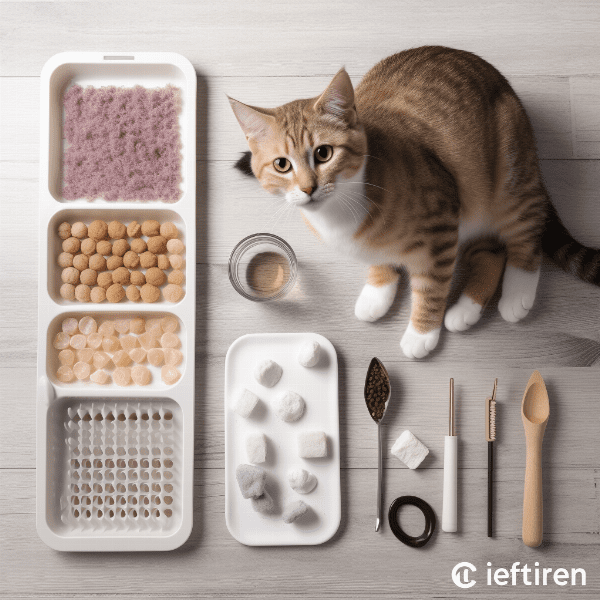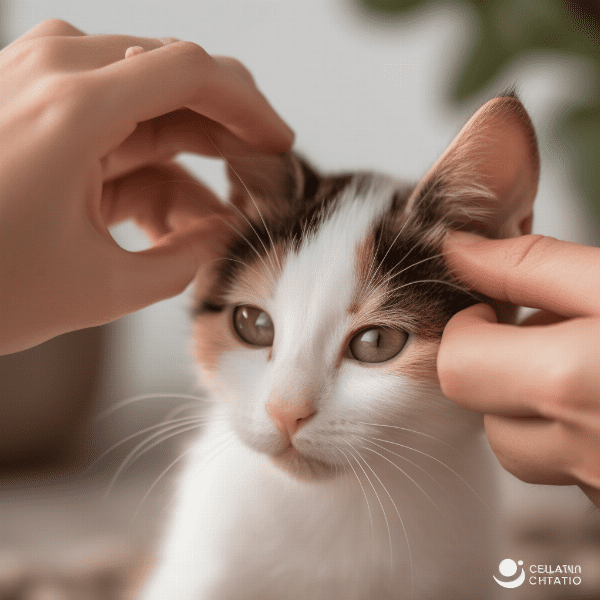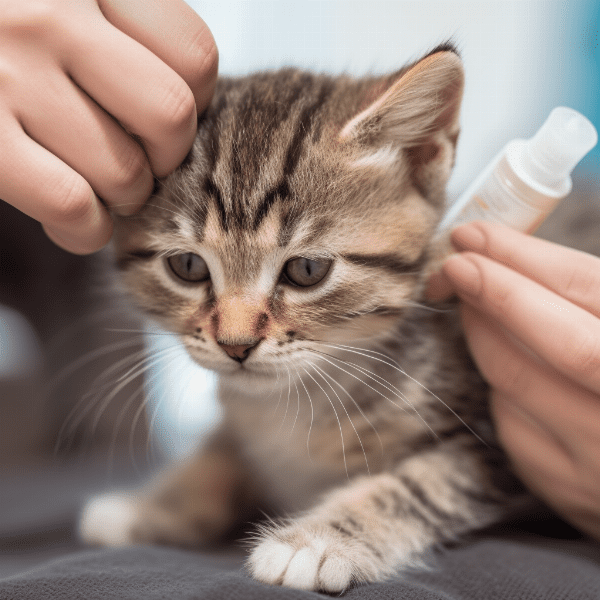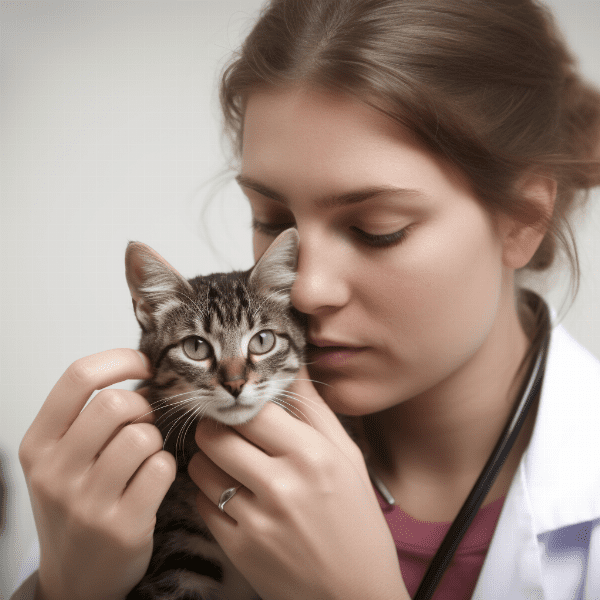Table of Contents
- Understanding Kitten Ear Wax: Causes and Symptoms
- Tools You’ll Need: A Checklist for Ear Cleaning
- How to Prepare Your Kitten for Ear Cleaning
- Step-by-Step Guide: How to Remove Kitten Ear Wax Safely
- Tips and Tricks for Preventing Kitten Ear Wax Buildup
- When to Seek Veterinary Help: Signs of Infection or Injury
- Final Thoughts: Caring for Your Kitten’s Ears
Understanding Kitten Ear Wax: Causes and Symptoms
Ear wax, also known as cerumen, is a naturally occurring substance that helps protect the ear canal from debris, moisture, and infection. However, when too much ear wax accumulates, it can cause a variety of problems for your kitten. In this section, we’ll explore the causes and symptoms of Kitten ear wax buildup.
What Causes Kitten Ear Wax Buildup?
There are several factors that can contribute to the buildup of ear wax in kittens. Some of the most common causes include:
- Ear Infections: Kittens that have ear infections are more likely to produce excessive ear wax as a result of the inflammation and irritation in their ear canals.
- Breed Predisposition: Certain breeds of cats, such as Persians and Himalayans, are more prone to ear wax buildup due to the shape and size of their ear canals.
- Allergies: Kitten allergies can cause inflammation and itching in the ears, leading to an increase in ear wax production.
- Poor Ear Hygiene: Kitten ear wax can also accumulate if their ears are not cleaned regularly, which can lead to an overgrowth of wax and debris.
What Are the Symptoms of Kitten Ear Wax Buildup?
It’s important to be able to recognize the signs of ear wax buildup in kittens so that you can take action to prevent further problems. Some common symptoms of kitten ear wax buildup include:
- Ear Scratching: Kittens with excessive ear wax may scratch or rub their ears frequently in an attempt to relieve the itching and discomfort.
- Head Shaking: If your kitten is shaking their head more than usual, it could be a sign that they are experiencing ear discomfort or pain.
- Odor: Ear wax buildup in kittens can produce an unpleasant odor that is often noticeable even from a distance.
- Discharge: In severe cases of ear wax buildup, a brown or black discharge may be visible in your kitten’s ears.
By understanding the causes and symptoms of kitten ear wax buildup, you can take steps to prevent it from becoming a bigger problem. In the next section, we’ll discuss the tools you’ll need to safely and effectively clean your kitten’s ears.

Tools You’ll Need: A Checklist for Ear Cleaning
Before you begin cleaning your kitten’s ears, it’s important to gather all the necessary tools to ensure a safe and effective cleaning process. In this section, we’ll provide you with a checklist of the tools you’ll need to clean your kitten’s ears.
- Ear Cleaning Solution: Choose a veterinarian-approved ear cleaning solution that is specifically formulated for cats. Avoid using products that contain alcohol, hydrogen peroxide, or other harsh chemicals, as they can irritate your kitten’s sensitive ears.
- Cotton Balls or Pads: Use cotton balls or pads to apply the ear cleaning solution and gently remove any excess ear wax.
- Tweezers or Forceps: You may need tweezers or forceps to remove any large or stubborn ear wax buildup that cannot be easily removed with a cotton ball or pad.
- Towel or Blanket: Use a towel or blanket to wrap your kitten and hold them still during the ear cleaning process. This can help prevent your kitten from squirming or moving around too much.
- Ear Powder: Ear powder can be used to absorb excess moisture in the ear canal, making it easier to remove ear wax. However, this tool is not essential and should only be used under the guidance of a veterinarian.
- Ear Scope: An ear scope can be used to examine the inside of your kitten’s ears and detect any signs of infection or injury. However, this tool is not necessary for routine ear cleaning.
By using the right tools and following the proper cleaning techniques, you can help prevent ear wax buildup in your kitten and keep their ears healthy and clean. In the next section, we’ll discuss how to prepare your kitten for the ear cleaning process.

How to Prepare Your Kitten for Ear Cleaning
Before you begin cleaning your kitten’s ears, it’s important to make sure they are comfortable and relaxed. Here are some tips to help you prepare your kitten for the ear cleaning process.
Choose the Right Time
Pick a time when your kitten is calm and relaxed, such as after a nap or a meal. Avoid cleaning your kitten’s ears when they are already agitated or anxious, as this can make the process more difficult and uncomfortable for both you and your kitten.
Create a Comfortable Environment
Choose a quiet and calm environment to clean your kitten’s ears. Turn off any loud music or distracting noises and make sure the room is well-lit. Place a towel or blanket on a flat surface and bring your kitten over to the area.
Familiarize Your Kitten with the Tools
Introduce your kitten to the tools you’ll be using for ear cleaning, such as the ear cleaning solution and cotton balls. Allow your kitten to sniff and explore the tools so they become more comfortable with them.
Provide Positive Reinforcement
Offer your kitten treats or praise during the ear cleaning process to help keep them calm and relaxed. Positive reinforcement can help your kitten associate ear cleaning with a positive experience.
By following these tips, you can help prepare your kitten for the ear cleaning process and ensure a smoother and more comfortable experience for both you and your kitten. In the next section, we’ll dive into the step-by-step guide for removing kitten ear wax safely.

Step-by-Step Guide: How to Remove Kitten Ear Wax Safely
Cleaning your kitten’s ears can seem daunting, but with the right tools and techniques, it can be done safely and effectively. Follow these step-by-step instructions to remove kitten ear wax safely.
Step 1: Apply the Ear Cleaning Solution
Begin by applying a small amount of ear cleaning solution to a cotton ball or pad. Gently place the cotton ball into your kitten’s ear canal, being careful not to push it too far in.
Step 2: Massage the Ear Canal
Gently massage the base of your kitten’s ear for approximately 30 seconds. This helps to loosen and dissolve any excess ear wax buildup.
Step 3: Remove Excess Wax
Remove the cotton ball from your kitten’s ear and use a new one to gently wipe away any excess ear wax that has been loosened by the ear cleaning solution. Be sure to never insert a cotton swab or any other object into your kitten’s ear canal, as this can cause injury.
Step 4: Repeat on Other Ear
Repeat the process on the other ear, using a fresh cotton ball or pad and ear cleaning solution.
Step 6: Provide Positive Reinforcement
Offer your kitten treats or praise to help reinforce positive associations with the ear cleaning process. This can help make future ear cleanings easier and less stressful for both you and your kitten.
By following these step-by-step instructions, you can safely and effectively remove ear wax buildup in your kitten and help keep their ears clean and healthy. In the next section, we’ll provide tips and tricks for preventing kitten ear wax buildup in the future.

Tips and Tricks for Preventing Kitten Ear Wax Buildup
Preventing ear wax buildup in your kitten is key to maintaining good ear health. Here are some tips and tricks for keeping your kitten’s ears clean and preventing future ear wax buildup.
Check for Signs of Infection
Regularly check your kitten’s ears for signs of infection, such as redness, inflammation, or discharge. If you notice any abnormalities, contact your veterinarian immediately.
Be Gentle
When cleaning your kitten’s ears, always be gentle and avoid inserting anything into the ear canal. Use only cotton balls or pads and be careful not to push them too far into the ear.
Monitor Allergies
If your kitten has allergies, work with your veterinarian to manage them effectively. Allergies can lead to increased ear wax production, so managing allergies can help prevent excessive ear wax buildup.
Watch for Breed Predispositions
If your kitten is a breed that is predisposed to ear wax buildup, such as a Persian or Himalayan, be extra vigilant about ear cleaning and monitor their ears regularly.
.

When to Seek Veterinary Help: Signs of Infection or Injury
In some cases, kitten ear wax buildup can lead to more serious ear problems, such as infections or injuries. It’s important to know when to seek veterinary help if you notice any signs of infection or injury in your kitten’s ears.
- Persistent Scratching: Kittens with ear infections may scratch or rub their ears frequently, even after being cleaned.
- Head Tilting: Your kitten may tilt their head to one side if they have an ear infection.
- Foul Odor: A strong, unpleasant odor coming from your kitten’s ears can indicate an ear infection.
- Discharge: If you notice any discharge from your kitten’s ears, it could be a sign of infection.
Signs of Injury
If your kitten has injured their ears, they may display symptoms such as:
- Bleeding: If you notice any bleeding from your kitten’s ears, seek veterinary help immediately.
- Discharge: Discharge or pus coming from your kitten’s ears can be a sign of injury.
- Swelling or Redness: If your kitten’s ears appear swollen or red, it could be a sign of an injury.
If you notice any of these signs in your kitten’s ears, seek veterinary help immediately. Your veterinarian can diagnose and treat any underlying ear problems and provide guidance on how to prevent future ear problems in your kitten.
In conclusion, with regular ear cleaning and monitoring, you can help prevent ear wax buildup in your kitten and keep their ears healthy and clean. Remember to always be gentle when cleaning your kitten’s ears and seek veterinary help if you notice any signs of infection or injury.

Final Thoughts: Caring for Your Kitten’s Ears
Caring for your kitten’s ears is an important part of their overall health and wellbeing. By following the tips and tricks in this guide, you can help prevent ear wax buildup and maintain healthy and clean ears for your kitten.
Regular Ear Cleaning
Regular ear cleaning is essential for preventing ear wax buildup and maintaining good ear health. Make ear cleaning a part of your kitten’s regular grooming routine, and be sure to use only veterinarian-approved ear cleaning solutions and tools.
Monitor for Signs of Infection or Injury
Regularly monitor your kitten’s ears for signs of infection or injury, such as redness, swelling, or discharge. Seek veterinary help immediately if you notice any abnormalities.
Work with Your Veterinarian
Your veterinarian can provide guidance and support in caring for your kitten’s ears. Be sure to work with your veterinarian to develop a comprehensive ear care plan for your kitten.
Provide a Healthy Diet
A healthy diet can help prevent ear infections and reduce the risk of ear wax buildup in kittens. Talk to your veterinarian about the best diet for your kitten’s specific needs.
By taking a proactive approach to caring for your kitten’s ears, you can help prevent ear problems and maintain good ear health. Remember to be gentle, provide positive reinforcement, and seek veterinary help if needed. With regular care and monitoring, you can help keep your kitten’s ears healthy and clean for years to come.




